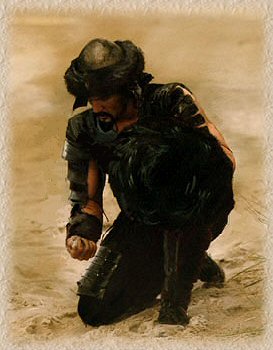A Tuchuk Man's Attire

Summer Garb
“And then I saw the first of the outriders, moving toward me, swiftly yet not seeming to hurry. I saw the slender line of his light lance against the sky, strapped across his back.
"I could see he carried a small rounded shield, glossy, black, lacquered; he wore a conical, fur rimmed iron helmet, a net of colored chains depending from the helmet protecting his face, leaving only holes for the eyes. He wore a quilted jacket and under this a leather jerkin; the jacket was trimmed with fur and had a fur collar; his boots were made of hide and also trimmed with fur; he had a wide, five-buckled belt. I could not see his face because of the net of chain that hung before it. I also noted, about his throat, now lowered, there was a soft leather wind scarf which might, when the helmet and veil was lifted, be drawn over the mouth and nose, against the wind and dust of his ride.
“He was very erect in the saddle. His lance remained on his back, but he carried in his right hand the small, powerful, horn bow of the Wagon Peoples and attached to his saddle was a lacquered, narrow, rectangular quiver containing as many as forty arrows. On the saddle there also hung, on one side, a coiled rope of braided bosk hide and, on the other, a long, three-weighted bola of the sort used in hunting tumits and men; in the saddle itself, on the right side, indicating the rider must be right handed, were the seven sheaths for the almost legendary quivas, the balanced saddle knives of the prairie. It was said a youth of the Wagon Peoples was taught the bow, the quiva, and the lance before their parents would consent to give them a name, for names are precious among the Wagon Peoples, as among Goreans in general, and they are not to be wasted on one who is likely to die, one who cannot handle the weapons of the hunt and war. Until the youth has mastered the bow, the quiva, and the lance he is simply known as the first, or the second, and so on, son of such and such a father."—Nomads, 10-11
Winter Garb
"The Wintering was not unpleasant, although, even so far north, the days and nights were often quite chilly; the Wagon Peoples and their slaves as well, wore boskhide and furs during this time; both male and female, slave or free, wore furred boots and trousers, coats and the flopping, ear-flapped caps that tied under the chin; in this time there was often no way to mark the distinction between the free woman and the slave girl, save that the hair of the latter must needs be unbound; in some cases of course, the Turian collar was visible, if worn on the outside of the coat, usually under the furred collar; the men too, free and slave were dressed similarly, save that the Kajiri, or he-slaves wore shackles, usually with a run of about a foot of chain."—Nomads, 59
General Info
. .
Men. .
Men. .
Women
. .
Women
. .
Slaves. .
Slaves. .
Visitors .
Visitors
|